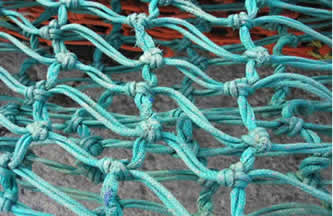 Crimond Enterprises Ltd.
Crimond Enterprises Ltd.
sell the popular and durable Ultra Cross knotless netting widely used for cod end material. UC black can be obtained in almost any mesh size needed for your particular use. The construction fiber used is high density polyethylene, woven into a unique pattern to create the most durable knotless netting available in the world to date. The thickness of the netting is counted in fibers used in construction (ply). For example: 120 ply would be about 2.5 mm; 420 ply about 5 mm; 600 ply about 7 mm; 800 ply about 9 mm; 1200 ply about 12 mm.
Ultra Cross Square Mesh
Why the Extra Cost:
UC Knotless netting is manufactured by a special process in diamond mesh only, therefore, square mesh panels can only be obtained by "squaring" the mesh. This process is labor intensive and explains why panels may have a join sewn by hand in them. In the squaring process it is impossible to get all clear panels.
UC Benefits:
UC netting has gained popularity among fishermen because of its ability to keep its square mesh shape and therefore retains fish better; also, the quality is better because there are no knots to score, or make dent marks in the fish. Knotted netting is prone to mesh distortion, and has a tendency to shrink more rapidly.
 Used Knotted Square Mesh Netting
Used Knotted Square Mesh Netting
UC Cod End Care:
Like any other netting, UC will shrink up over time. The better you care for the netting the longer it will last and stay within regulation limits.
Here are a few pointers:
- Make sure it is washed well to remove all sand and mud, (One of the main causes of shrinkage.)
- Keep it out of the sun. Cover the cod end when on the net-drum for extended periods.
- Store in a cool shady place. Avoid leaving on a wharf in sunlight.
- Take measurements only when the cod end is soaking wet.
- Ensure your measuring instruments and techniques replicate that of your fishery officers.
This is expensive netting to produce and purchase, this fact does not change the process of time and its effect on synthetic fibers, Crimond purchases all cod end materials from the factory with a 5% safety margin on mesh size and all netting sold to customers is regulation size + when it leaves our shop. Crimond Enterprises Ltd cannot and will not guarantee your UC cod end from shrinkage when used.
Fishing with a cod end that is within regulation limits is the final responsibility of the Captain.
The Codend:
In more and more trawl selectivity experiments the emphasis is increasing on the study of the Codend and Extension. The majority of codend experiments are on the following:
Mesh Size. Regulating a minimum mesh size.Mesh Configuration. Diamond V Square or T 90 mesh.
These experiments now have another agenda that of fish quality. Downgrading of fish quality begins in the codend and it has now been established by the use of underwater cameras, that because of the absence of knots, knotless netting reduces abrasion of the fish.
It has been noted that codends are extremely unstable under tow, partly as a result of the turbulent flow around the catch build up. This same turbulence also shifts the fish around the codend causing abrasion, which leads to scale removal, bruising, and dimple marks. All this negative movement reduces the product shelf life, and often marks the fillet of the fish.
Although it has not been well documented fish captured in knotless codends are of superior quality to those caught in knotted codends in either square or diamond mesh.


